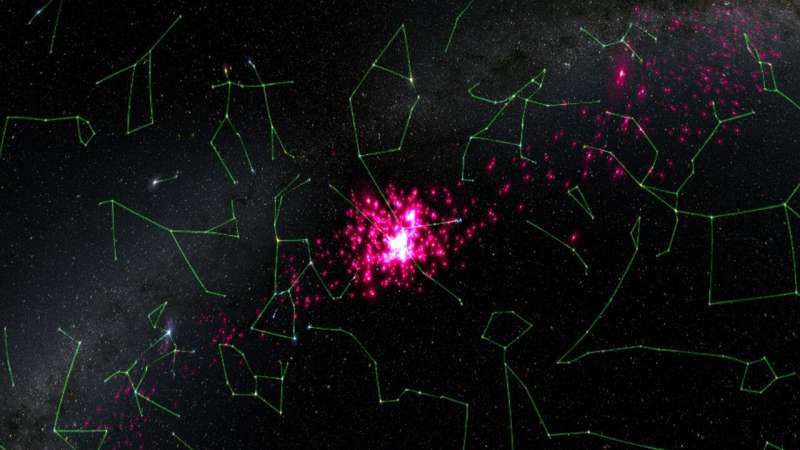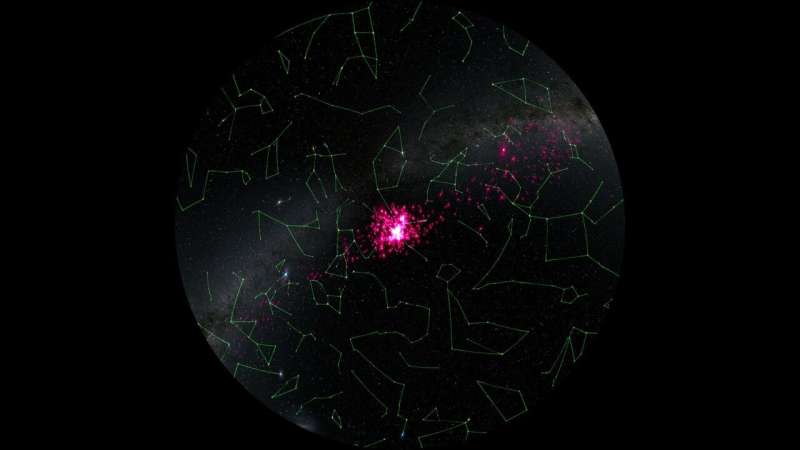Is the nearest star cluster to the sun being destroyed?

Data from ESA's Gaia star mapping satellite have revealed tantalizing evidence that the nearest star cluster to the sun is being disrupted by the gravitational influence of a massive but unseen structure in our galaxy.
If true, this might provide evidence for a suspected population of 'dark matter sub-halos." These invisible clouds of particles are thought to be relics from the formation of the Milky Way, and are now spread across the galaxy, making up an invisible substructure that exerts a noticeable gravitational influence on anything that drifts too close.
ESA Research Fellow Tereza Jerabkova and colleagues from ESA and the European Southern Observatory made the discovery while studying the way a nearby star cluster is merging into the general background of stars in our galaxy. This discovery was based on Gaia's Early third Data Release (EDR3) and data from the second release.
The team chose the Hyades as their target because it is the nearest star cluster to the sun. It is located just over 153 light years away, and is easily visible to skywatchers in both northern and southern hemispheres as a conspicuous "V' shape of bright stars that marks the head of the bull in the constellation of Taurus. Beyond the easily visible bright stars, telescopes reveal a hundred or so fainter ones contained in a spherical region of space, roughly 60 light years across.

A star cluster will naturally lose stars because as those stars move within the cluster they tug at each other gravitationally. This constant tugging slightly changes the stars' velocities, moving some to the edges of the cluster. From there, the stars can be swept out by the gravitational pull of the galaxy, forming two long tails.
One tail trails the star cluster, the other pulls out ahead of it. They are known as tidal tails, and have been widely studied in colliding galaxies but no one had ever seen them from a nearby open star cluster, until very recently.
The key to detecting tidal tails is spotting which stars in the sky are moving in a similar way to the star cluster. Gaia makes this easy because it is precisely measuring the distance and movement of more than a billion stars in our galaxy. "These are the two most important quantities that we need to search for tidal tails from star clusters in the Milky Way," says Tereza.
Previous attempts by other teams had met with only limited success because the researchers had only looked for stars that closely matched the movement of the star cluster. This excluded members that left earlier in its 600–700 million year history and so are now traveling on different orbits.
To understand the range of orbits to look for, Tereza constructed a computer model that would simulate the various perturbations that escaping stars in the cluster might feel during their hundreds of millions of years in space. It was after running this code, and then comparing the simulations to the real data that the true extend of the Hyades tidal tails were revealed. Tereza and colleagues found thousands of former members in the Gaia data. These stars now stretch for thousands of light years across the galaxy in two enormous tidal tails.
But the real surprise was that the trailing tidal tail seemed to be missing stars. This indicates that something much more brutal is taking place than the star cluster gently 'dissolving."
Running the simulations again, Tereza showed that the data could be reproduced if that tail had collided with a cloud of matter containing about 10 million solar masses. "There must have been a close interaction with this really massive clump, and the Hyades just got smashed," she says.
But what could that clump be? There are no observations of a gas cloud or star cluster that massive nearby. If no visible structure is detected even in future targeted searches, Tereza suggests that object could be a dark matter sub-halo. These are naturally occurring clumps of dark matter that are thought to help shape the galaxy during its formation. This new work shows how Gaia is helping astronomers map out this invisible dark matter framework of the galaxy.
"With Gaia, the way we see the Milky Way has completely changed. And with these discoveries, we will be able to map the Milky Way's sub-structures much better than ever before," says Tereza. And having proved the technique with the Hyades, Tereza and colleagues are now extending the work by looking for tidal tails from other, more distant star clusters.
More information: Tereza Jerabkova et al. The 800 pc long tidal tails of the Hyades star cluster, Astronomy & Astrophysics (2021). DOI: 10.1051/0004-6361/202039949
Journal information: Astronomy & Astrophysics
Provided by European Space Agency





















